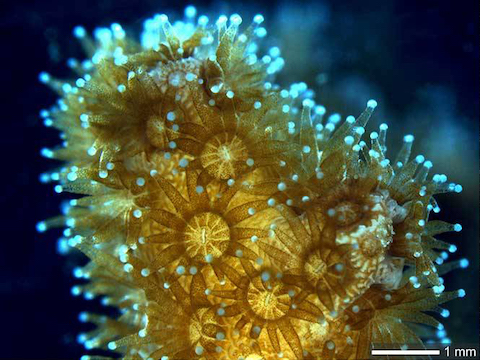
Credit: Isabelle Domart-Coulon, National Museum of Natural History Paris.
Here’s a riddle for you: What animal behaves like a plant?
The answer is coral. These tiny, transparent organisms live mostly in colonies, connected by living tissue through which they share nutrients.
But they often can’t consume enough nutrients to live. So, they rely on special symbiotic algae in their tissues—meaning most corals require sunlight, like a plant.
The algae take in sun and carbon dioxide and produce oxygen and sugars, which the corals consume to grow and produce the hard exoskeletons that give the reef its shape.
However, seas are becoming warmer and more acidic, which stresses the corals’ algae, causing them to produce toxins. The corals respond by expelling or digesting them.
Without the algae, the corals lose their nutrients and their vibrant colors, which is why this is called “bleaching.” If they can’t replace their algae, they die.
In the last decade, a third of the world’s reefs experienced some bleaching and coral death.
But some parts of these reefs survived, and scientists have realized it’s because their algae could tolerate the heat, acidity, or both.
Scientists are now sequencing the DNA of these “super algae” to see if they could genetically enhance other coral algae to make them hardier.
Coral reefs are a source of great biodiversity in the ocean and support the livelihoods of half a billion people around the world.
Good reasons to hope we can help them adapt to warmer seas.
Background
Synopsis: Stony coral polyps are tiny transparent colonial animals that build reefs in shallow seas. They rely on the colorful symbiotic algae that they shelter in their tissues to provide most of their energy and nutrients through photosynthesis. Corals have benefited from this relationship for more than 200 million years. However, when seawater temperatures rise, overheated algae struggle and produce toxins, causing the polyps to expel or digest their algae. Without these symbionts, the coral appears white, so this action is known as coral bleaching. Corals can survive short bleaching episodes by resorbing healthy algae, but longer episodes without their symbionts causes the polyps to die. Recent studies have shown that increasing the heat tolerance of the algae can help corals to survive rising ocean temperatures.
- Corals have mystified scientists for millennia—are they “animal, vegetable, or mineral?”
- Around 300 BCE, one of Aristotle’s students, Theophrastus, described red coral as a mineral in one text, and then as a plant in another later text.
- During the first century CE, Pliny the Elder believed corals and sponges were neither plants nor animals but constituted a third type of life.
- In the 11th century, Persian Al-Biruni classified corals and sponges as animals because they responded to touch.
- In the 18th century, William Herschel examined coral under a microscope and confirmed that it had the thin cell membranes of an animal.
- Today corals are classified as animals of the Class Anthozoa.
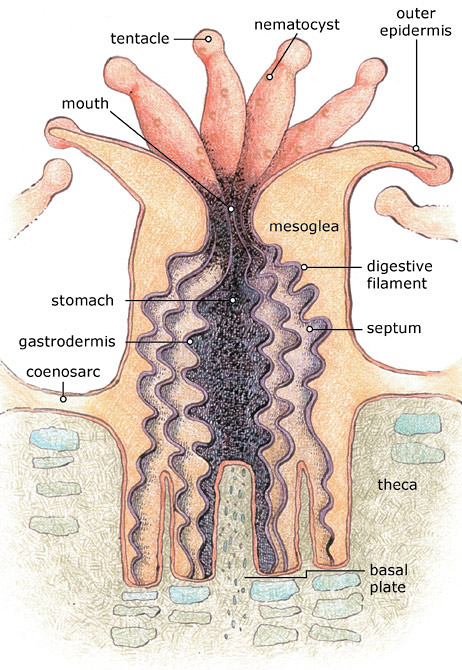
Credit: NOAA
- Corals are marine invertebrates characterized by colonies of genetically identical polyps.
- They are similar to their cousins the sea anemones, except corals produce mineral skeletons.
- Coral polyps are tiny saclike animals that range from less than 1/16th inch (1.5 mm) to around 1 inch (2.5 cm) in size, in a variety of cylindrical to disc-like shapes.
- They have a single opening to their stomach that includes an orifice surrounded by a ring of tentacles at the open end. They use their tentacles to capture food, clear waste, and defend themselves.
- Coral polyps build white calcium carbonate exoskeletons called corallites that form cuplike calyxes that they retract into for protection. They typically extend their tentacles at night for hunting.
- Coral colonies consist of thousands to millions of individuals connected by living tissue called the coenosarc, across which they share circulation and nutrients.
- Colonies can expand by reproducing polyps asexually or can spin off new colonies by spawning rafts that float off to anchor nearby on the seafloor.
- As the colony grows, the conjoined mineral skeletons form reefs of various shapes and sizes depending on the species, light level, and water circulation.
- To feed, corals have stinging nematocysts on their tentacles that enable them to stun and capture small marine organisms like plankton and fish larvae.
- Using only this feeding mechanism, some deepwater and soft corals survive in waters as deep as 10,800 ft (3,300 m) and in cold waters near the coasts of Scotland and Alaska.
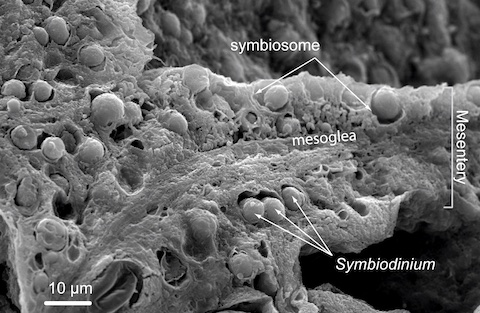
Credit: Allisonmlewis, CC BY-SA 4.0, via Wikimedia Commons
- However, most shallow-water corals require more energy and nutrients than they can capture while fixed to the seafloor, so they rely on a symbiotic relationship with single-celled algae to provide them with additional energy and nutrients.
- Zooxanthellae (zoh-uh-zan-THELL-ee) are colorful single-celled dinoflagellate algae that shelter within the surface tissues of these coral polyps.
- The algae use the sun’s energy, carbon dioxide, and polyp waste products to produce oxygen, glucose, glycerol, and amino acids via photosynthesis, passing on up to 90 percent of these to the polyps, which use them to make proteins, fats, carbohydrates, and calcium carbonate for their exoskeletons.
- Since their symbionts need sunlight, these stony corals respond to the environment like plants would—they can only grow in clear water at depths of 200 ft (60 m) or less.
- The vivid greens, browns, and reds we see in reefs are produced by many different species of these algae. The mineral exoskeletons are usually white but can sometimes be shades of light purple and blue.
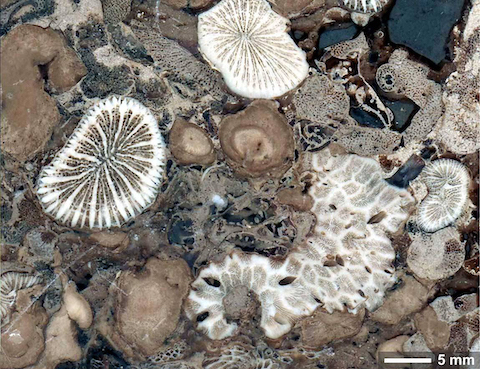
Credit: Jarosław Stolarski, Polish Academy of Sciences
- The mutualistic relationship of coral and algae drives reef building, characterized by daily photosynthetic surges in growth that produce microscopic banding in the corallites.
- Fossil corals from the Triassic Period of Turkey exhibit this microscopic daily banding along with other indicators suggesting the mutualistic relationship between coral and algae has been operating for more than 200 million years.
- When reefs are stressed by high temperature, adverse water chemistry, or too much ultraviolet light, they may “bleach,” turning white—but what is really happening is the coral polyps are expelling or digesting their stressed symbiont “meal tickets.”
- This amounts to a crash diet for the polyps since the algae provide up to 90 percent of their nutrition.
- Polyps selectively digest less-productive algae on a regular basis, replacing them with healthier algae in the water column to optimize nutrition. However, environmental stressors such as increasing temperature may damage the photosynthetic machinery of their native zooxanthellae, causing them to release toxins, which forces the polyps to expel the algae—along with their color.
- Sometimes the corals turn bright colors for about a week after expelling their symbionts, creating pigment to protect themselves from increased solar radiation, but they usually bleach soon afterward.
- When they bleach, corals are still alive. Polyps can survive for short periods until they can regain healthy algae from the water column or regenerate their symbiont population from their own surviving algae.
- Over long periods without enough healthy symbionts, entire colonies of polyps may die. This can also occur if the stressed-zooxanthellae toxins build up in the colony.
- During an intense heat wave in 2015, scientists noticed some Bahamian reefs survived while nearby reefs died. Survivor “super reefs” appeared to be adapting to higher temperatures.
- Using electron microscopy, scientists determined that different groups of zooxanthellae species (called clades) have different heat tolerances, water-quality tolerances, and photosynthetic productivities.
- Most of these symbionts thrive at water temperatures around 68–80°F (20–27°C) but start to struggle and produce toxins at temperatures of around 86°F (30°C).
- But, some zooxanthellae clades have adapted to remain healthy at temperatures of 93°F (32°C), and corals may preferentially take up these more heat-tolerant algae to survive bleaching episodes.
- Researchers are sequencing genetic data from these “super algae” to work out whether it might be possible to genetically enhance zooxanthellae so more species are able to maintain their symbiotic relationship with corals in warmer oceans, with the goal of decreasing future coral bleaching and death.
- Other species of zooxanthellae have adapted to tolerate more acidic waters, so there is hope that adaptation to other environmental stressors is also possible.
- Between 2014–2017, the U.S. National Oceanic and Atmospheric Administration (NOAA) estimates that heat stress triggered bleaching in 75 percent of Earth’s tropical corals, killing coral on some 30 percent of the world’s reefs.
- About half the corals on Australia’s 1,500-mile-long (2,400 km) Great Barrier Reef have died in the past decade.
- There have been six major extinctions during the 400-million-year history of corals on Earth that have been related to ocean heating and acidification.
- None of these geological events happened as rapidly as the water quality changes impacting corals today, so accelerating adaptation is vital.
- Although it has taken tens of thousands of years after each of these extinctions, corals have ultimately adapted and returned to abundance in the oceans.
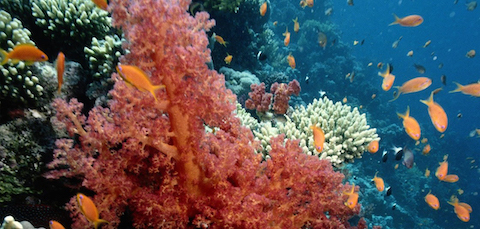
Credit: NOAA
- Coral reefs protect shorelines from wave energy and hurricanes, providing natural lagoons and biodiverse habitat for marine animals.
- The livelihoods of more than 500 million people are related to the tourism and commercial fishing that occurs around reefs.
- Similar to rain forest species, some reef dwellers like sea squirts show promise as sources of new compounds for drugs for the treatment of cancer and even viruses—like COVID-19.
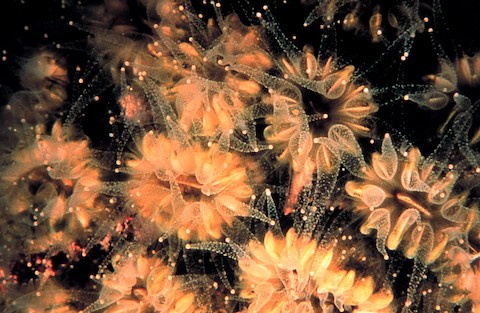
Credit: Florida Keys National Marine Sanctuary Staff, public domain, via Wikimedia Commons.

